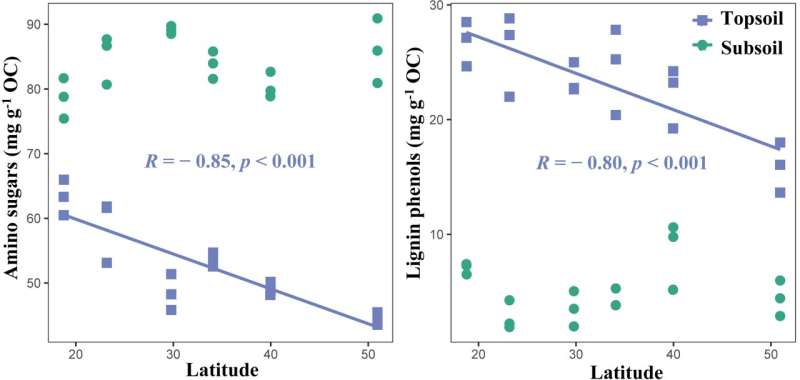This article has been reviewed according to Science X's editorial process and policies. Editors have highlighted the following attributes while ensuring the content's credibility:
fact-checked
trusted source
proofread
Study reveals latitude patterns, controlling factors of microbial residues and lignin phenol accumulation in forest soil

Soil organic carbon (SOC) can be divided into plant-derived and microbial-derived carbon. Studying the latitudinal variation of these two sources and their controlling factors is critical to understanding SOC persistence and stabilization.
To analyze the variation of plant and microbial-derived carbon in topsoil and subsoil along different latitude gradients, researchers from the Wuhan Botanical Garden of the Chinese Academy of Sciences selected six typical forests, ranging from Jianfengling to Genhe along a latitude gradient as study sites. Amino sugars and lignin phenols were used as biomarkers to indicate microbial- and plant-derived carbon, respectively.
The work, published in Journal of Soils and Sediments is titled "Persistence of soil microbial residuals and lignin phenols in forest ecosystems along the latitude gradient."
The researchers comprehensively analyzed the effects of climate, vegetation, soil, and microbial properties on the concentration changes of lignin phenols and microbial residues in topsoil and subsoil along the latitude gradient.
They found that the amino sugars and lignin phenols contribute up to 50%–75% of the SOC, and their contributions decrease with latitude. The contributions of the former increase with soil depth, while the opposite is true for the latter.
Climate and soil physicochemical properties mainly control the persistence of microbial residues and lignin phenols in the topsoil, and soil clay is the critical factor in determining the microbial residues and lignin phenols in the subsoil.
These results have guiding significance for understanding the contribution and accumulation mechanism of organic carbon from lignin phenols and microbial residues in forest soils, and are helpful for predicting the carbon sink potential of forest ecosystems under future global climate change.
More information: Qiaoling Lin et al, Persistence of soil microbial residuals and lignin phenols in forest ecosystems along the latitude gradient, Journal of Soils and Sediments (2024). DOI: 10.1007/s11368-024-03794-x
Provided by Chinese Academy of Sciences



















